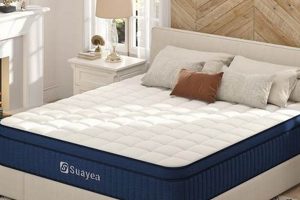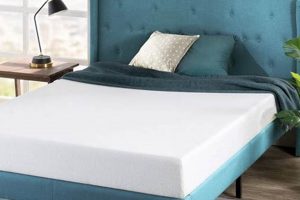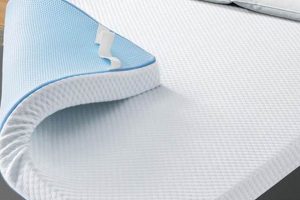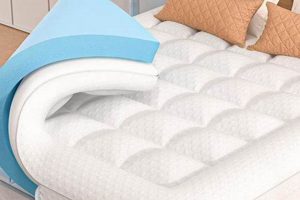A sleeping surface measuring twelve inches in thickness, designed to fit a bed frame of standard queen dimensions, is a common choice for residential use. This size configuration offers a balance between support, comfort, and ease of handling. As an example, it provides more cushioning than thinner options while remaining manageable for transportation and installation in a standard-sized bedroom.
The appeal of this particular size stems from several factors. The increased depth often equates to enhanced support and pressure relief, particularly for side sleepers or individuals with back pain. Historically, thicker sleeping surfaces were associated with higher quality and greater longevity, a perception that continues to influence consumer preferences. Furthermore, the queen size remains a popular choice for couples due to its balance between space and affordability.
The subsequent sections will delve into the material composition typically found within such a product, examine the various construction techniques employed in its manufacturing, and outline the key considerations when selecting one suitable for individual needs and preferences. Performance metrics, such as motion isolation and temperature regulation, will also be addressed.
Guidance for Selecting a Suitable Option
The selection process necessitates careful consideration of individual sleeping preferences, budgetary constraints, and long-term needs. The following guidelines offer assistance in making an informed purchasing decision.
Tip 1: Prioritize Support and Spinal Alignment: Assess the level of firmness required to maintain proper spinal alignment during sleep. The ideal firmness will vary depending on body weight and preferred sleeping position. Side sleepers typically benefit from a softer surface that allows the shoulder and hip to sink in, while back and stomach sleepers often require a firmer surface to prevent excessive sagging.
Tip 2: Evaluate Material Composition: Consider the materials used in its construction, such as memory foam, latex, or innerspring coils. Each material offers unique properties in terms of comfort, support, and durability. Memory foam conforms to the body’s contours, while latex provides a more responsive and buoyant feel. Innerspring coils offer traditional support and airflow.
Tip 3: Assess Motion Isolation Properties: If sharing the bed with a partner, evaluate the ability to isolate motion. Memory foam and pocketed coil systems tend to excel at minimizing motion transfer, preventing disturbances caused by movement.
Tip 4: Investigate Temperature Regulation: Consider cooling features if prone to overheating during sleep. Look for materials such as gel-infused memory foam, breathable latex, or coil systems designed to promote airflow and dissipate heat.
Tip 5: Research the Density of Foam Layers: Pay attention to the density of foam layers, particularly in memory foam models. Higher density foams tend to be more durable and resistant to compression over time, resulting in a longer lifespan.
Tip 6: Inspect Edge Support Construction: Examine the edge support system to ensure adequate stability and prevent sagging along the perimeter. Reinforced edges can provide a larger usable sleep surface and make it easier to get in and out of bed.
Tip 7: Review Warranty and Return Policies: Carefully review the manufacturer’s warranty and return policies before making a purchase. A comprehensive warranty and a generous return window offer peace of mind and allow for testing the product in the home environment.
Adhering to these guidelines will aid in identifying a suitable option that provides optimal comfort, support, and longevity, contributing to improved sleep quality.
The subsequent discussion will concentrate on common performance issues and provide guidance on maintenance best practices.
1. Thickness and Support
The relationship between thickness and support is a fundamental consideration in the selection of a sleeping surface, particularly when evaluating a product characterized as a “12 inch mattress queen.” Thickness directly contributes to the overall structural integrity of the mattress, influencing its capacity to provide adequate support for the sleeper’s body. A greater thickness, as exemplified by the 12-inch designation, generally implies a greater volume of material available for providing both cushioning and resistance to compression. The causal effect of increased thickness is, therefore, a potentially enhanced level of support. For instance, a thicker mattress may incorporate multiple layers of varying densities, each designed to fulfill a specific function, such as contouring to the body’s shape or providing a firm foundation.
In the context of a “12 inch mattress queen,” the significance of this relationship lies in its impact on spinal alignment and pressure relief. A mattress lacking sufficient thickness may fail to provide adequate support, leading to improper spinal alignment and increased pressure points, particularly in the shoulders, hips, and knees. Conversely, a 12-inch mattress, if appropriately constructed, can distribute weight more evenly, reducing pressure and promoting a more neutral spinal posture. Consider, for example, an individual with back pain; a thicker mattress with targeted support zones can significantly alleviate discomfort and improve sleep quality. The understanding of this connection is practically significant for consumers seeking a sleeping surface that effectively addresses their individual needs and promotes long-term well-being.
In summary, the thickness of a mattress is inextricably linked to its support capabilities, with the “12 inch mattress queen” offering a notable example of this principle. While thickness alone does not guarantee optimal support, it serves as a crucial parameter influencing the overall performance of the sleeping surface. Challenges may arise in determining the ideal thickness for individual needs, necessitating careful consideration of factors such as body weight, sleeping position, and underlying health conditions. Nevertheless, the connection between thickness and support remains a central theme in the broader evaluation of mattress quality and its potential to contribute to restful sleep.
2. Queen Size Dimensions
Queen size dimensions, defined as 60 inches in width and 80 inches in length, constitute an integral element of the 12 inch mattress queen designation. These specific measurements determine the physical compatibility of the mattress with standard queen-sized bed frames. The effect of adhering to these dimensions ensures the product fits properly within the intended structure. For example, a mattress deviating significantly from these measurements would likely experience overhang or insufficient support, rendering the ensemble unstable and potentially uncomfortable.
The importance of queen size dimensions lies in their prevalence and standardization within the bedding industry. This standardization facilitates ease of replacement and interchangeability. For instance, consumers purchasing a 12 inch mattress queen expect it to seamlessly integrate with their existing queen-sized bed frame without requiring modifications. Manufacturers adhere to these specifications to meet consumer expectations and maintain compatibility across a broad range of bedding accessories, such as sheets and mattress protectors. This conformity minimizes user error and enhances overall consumer satisfaction.
In summary, the queen size dimensions represent a critical component of the 12 inch mattress queen, dictating compatibility and interchangeability. The challenges arise when non-standard dimensions are introduced, requiring careful consideration of fit and potential modifications. The standardization of these dimensions promotes practicality and efficiency within the broader bedding ecosystem.
3. Material Composition
The constituent materials within a 12-inch mattress queen significantly determine its performance characteristics, including support, comfort, temperature regulation, and durability. The selection and arrangement of these materials directly affect the overall sleeping experience.
- Core Materials and Support
The core of a 12-inch mattress queen frequently incorporates innerspring coils, foam (polyurethane, memory foam, or latex), or a hybrid combination. Innerspring systems offer traditional support and airflow, while foam cores contour to the body to relieve pressure points. The density and arrangement of coils or foam layers impact the firmness and the level of support provided, influencing spinal alignment and reducing pressure.
- Comfort Layers and Surface Feel
Comfort layers, often positioned above the core, consist of materials designed to enhance the initial feel of the mattress. These layers commonly include memory foam, latex, or quilted textiles. Memory foam conforms to the sleeper’s shape, providing pressure relief and motion isolation. Latex offers a more responsive and buoyant feel. The thickness and density of these layers determine the softness and responsiveness of the sleeping surface.
- Cover Materials and Breathability
The outermost cover of a 12-inch mattress queen is crucial for regulating temperature and moisture. Materials such as cotton, wool, or synthetic fabrics (e.g., polyester blends) are frequently used. Cotton is breathable and absorbent, while wool offers natural temperature regulation and moisture-wicking properties. Synthetic fabrics may offer enhanced durability or stain resistance. The cover’s weave and construction contribute to airflow and overall comfort.
- Transition Layers and Gradual Support
Transition layers, positioned between the core and comfort layers, serve to bridge the gap in firmness and density. These layers commonly consist of polyfoam or convoluted foam. Their purpose is to provide a gradual transition from the supportive core to the softer comfort layers, preventing abrupt changes in feel and enhancing overall comfort and support. The density and thickness of these layers impact the smoothness of the transition and the overall comfort profile of the mattress.
Understanding the interplay between these material components is essential for selecting a 12-inch mattress queen that meets individual needs and preferences. Each material possesses unique properties that contribute to the overall performance and longevity of the mattress, directly impacting the quality of sleep.
4. Comfort Level
The comfort level associated with a 12-inch mattress queen is a multifaceted characteristic arising from the interplay of material composition, construction techniques, and individual preferences. A direct cause-and-effect relationship exists between these elements and the subjective perception of comfort. For instance, a mattress employing high-density memory foam in its comfort layers will typically exhibit a different feel than one utilizing traditional innerspring coils. The importance of comfort level, in the context of a 12-inch mattress queen, lies in its direct correlation with sleep quality and overall well-being. An uncomfortable sleeping surface can lead to disrupted sleep patterns, musculoskeletal discomfort, and reduced daytime performance.
Consider a real-life example: an individual with chronic back pain may find a medium-firm 12-inch mattress queen, incorporating targeted lumbar support, to be significantly more comfortable than a softer, less supportive option. The practical significance of understanding this connection extends to the purchasing process. Consumers who actively evaluate the comfort level, based on their specific needs and preferences, are more likely to select a mattress that promotes restful sleep and minimizes discomfort. For example, side sleepers often require a softer surface to accommodate shoulder and hip pressure, while stomach sleepers typically benefit from a firmer feel to maintain spinal alignment.
In summary, the comfort level of a 12-inch mattress queen is a critical attribute that directly influences sleep quality and physical well-being. Challenges arise in quantifying subjective comfort preferences, necessitating careful consideration of material composition, construction, and individual needs. Ultimately, a thorough understanding of the factors contributing to comfort enables informed decision-making and the selection of a sleeping surface that effectively promotes restorative sleep.
5. Durability and Longevity
Durability and longevity represent crucial attributes directly affecting the long-term value and overall satisfaction associated with a 12-inch mattress queen. A direct causal relationship exists between the quality of materials, construction techniques, and the lifespan of the product. Higher-quality materials, such as high-density foams and robust coil systems, demonstrably extend the useful life of a mattress. The absence of such quality, conversely, precipitates premature degradation, necessitating more frequent replacement. The importance of durability and longevity in the context of a 12-inch mattress queen lies in its economic implications and its contribution to consistent sleep quality over an extended period. A durable mattress maintains its support and comfort characteristics, while a less durable mattress may exhibit sagging, reduced support, and increased pressure points, negatively impacting sleep quality.
Consider the example of two 12-inch mattress queen products: one constructed with low-density polyurethane foam and a light-gauge coil system, and another built with high-density memory foam and a reinforced pocketed coil system. The former may exhibit significant sagging and degradation within a few years, leading to discomfort and the need for replacement. The latter, however, may maintain its support and comfort characteristics for a decade or more, representing a more economical long-term investment. Understanding this distinction is practically significant for consumers seeking to maximize the return on their purchase. Factors such as the density of foams, the gauge and construction of coils, and the quality of cover materials all contribute to the overall durability and longevity of the mattress.
In summary, durability and longevity are paramount considerations when evaluating a 12-inch mattress queen. The use of high-quality materials and robust construction techniques directly contributes to the product’s lifespan and its ability to maintain consistent support and comfort over time. While assessing durability can be challenging prior to purchase, careful examination of product specifications, warranty information, and customer reviews can provide valuable insights. Ultimately, prioritizing durability and longevity represents a prudent investment in long-term sleep quality and economic value.
6. Spinal Alignment
Spinal alignment, in the context of a 12 inch mattress queen, refers to the neutral positioning of the vertebrae during sleep, mimicking the natural curvature of the spine while standing. The selection of a mattress directly influences the ability to maintain this alignment, which in turn affects musculoskeletal health and overall sleep quality. A 12 inch mattress queen, possessing adequate thickness and appropriate firmness, can promote optimal spinal alignment by providing sufficient support and contouring to the sleepers body. Failure to achieve this alignment may lead to back pain, stiffness, and disrupted sleep.
The importance of spinal alignment is underscored by its direct impact on biomechanical stress. For example, a too-soft mattress may cause excessive sinking of the hips, leading to spinal curvature and strain on surrounding muscles. Conversely, a too-firm mattress may create pressure points and prevent proper contouring, similarly disrupting alignment. A 12 inch mattress queen, if properly designed, offers a balance between support and pressure relief, enabling the spine to maintain its natural curvature. Consider the case of an individual with scoliosis; a mattress that fails to provide adequate support in specific areas can exacerbate spinal curvature and increase discomfort. The practical significance of understanding this connection lies in the ability to select a mattress that mitigates these risks and promotes a healthier sleep posture. Mattress characteristics to consider include support, contour and materials.
In summary, spinal alignment represents a critical consideration when evaluating a 12 inch mattress queen. Its attainment is dependent on factors such as mattress firmness, material composition, and individual sleep preferences. Challenges in achieving optimal alignment may arise from varying body types, pre-existing conditions, and subjective comfort perceptions. However, prioritizing spinal alignment in the mattress selection process offers significant benefits in terms of musculoskeletal health and improved sleep quality.
Frequently Asked Questions
The following section addresses common inquiries regarding the specifications, performance, and maintenance of a sleeping surface identified as a “12 inch mattress queen.” These questions are intended to provide clarity and assist in informed decision-making.
Question 1: What is the significance of the 12-inch thickness in a queen-sized mattress?
The 12-inch thickness generally indicates a greater potential for both support and comfort compared to thinner models. This dimension allows for the incorporation of multiple layers of varying densities and materials, each designed to serve a specific function. The 12-inch thickness is not, however, a guarantee of superior performance; material quality and construction methods remain critical factors.
Question 2: Does a 12 inch mattress queen require special bed frames or support systems?
A standard queen-sized bed frame, designed to accommodate a mattress of typical dimensions, is generally suitable. Reinforcement of the frame may be necessary for heavier individuals or couples to ensure adequate support and prevent sagging. Slatted frames should have closely spaced slats to provide uniform support.
Question 3: How does the material composition of a 12 inch mattress queen affect its suitability for different sleeping positions?
Material composition significantly impacts the suitability for various sleeping positions. Side sleepers typically benefit from softer materials, such as memory foam or latex, which allow for contouring around the shoulders and hips. Back and stomach sleepers often require firmer surfaces, such as innerspring or hybrid models, to maintain spinal alignment.
Question 4: What are the recommended maintenance practices for a 12 inch mattress queen to prolong its lifespan?
Regular rotation of the mattress, typically every three to six months, helps to distribute wear and prevent localized sagging. The use of a mattress protector is recommended to guard against spills, stains, and allergens. Avoid jumping or standing on the mattress, as this can damage the internal structure. Follow the manufacturer’s cleaning instructions for spot cleaning or stain removal.
Question 5: What are the potential advantages of a hybrid construction in a 12 inch mattress queen?
Hybrid construction, combining elements of both innerspring and foam mattresses, can offer a balance of support, comfort, and motion isolation. Innerspring coils provide traditional support and airflow, while foam layers, such as memory foam or latex, offer contouring and pressure relief. This combination may appeal to individuals seeking the benefits of both mattress types.
Question 6: How does the density of foam layers in a 12 inch mattress queen relate to its overall durability?
Foam density is a key indicator of durability. Higher-density foams generally exhibit greater resistance to compression and degradation over time, resulting in a longer lifespan. Low-density foams may compress more readily, leading to sagging and reduced support.
In summary, selecting a 12-inch mattress queen involves careful consideration of thickness, material composition, maintenance requirements, and individual preferences. Understanding these factors contributes to a more informed purchasing decision and enhances the likelihood of long-term satisfaction.
The subsequent section will explore specific brands and models available in the market, offering comparative insights into their respective features and performance characteristics.
The Enduring Significance of a Standardized Sleeping Surface
This examination of the twelve-inch mattress queen has traversed its defining characteristics, including dimensions, material composition, and implications for comfort and support. The analysis has highlighted the importance of adhering to established standards to ensure compatibility and optimize sleep quality. The attributes of this widespread sleeping platform, while seemingly commonplace, warrant careful consideration to facilitate informed consumer choices.
As material science advances, the fundamental principles of support and comfort must remain central to the design and selection of a mattress. Future innovations should prioritize both individual needs and environmental sustainability, further refining the function and efficacy of this essential component of the domestic environment. The continued evolution of this design is anticipated, emphasizing both performance and responsible resource management.




![Best Twin Memory Foam Mattress 8 Inch For [Better Sleep] Organic & Natural Mattress Buyer’s Guide: Non-Toxic Sleep Solutions Best Twin Memory Foam Mattress 8 Inch For [Better Sleep] | Organic & Natural Mattress Buyer’s Guide: Non-Toxic Sleep Solutions](https://mattressworldpa.com/wp-content/uploads/2025/07/th-3687-300x200.jpg)


